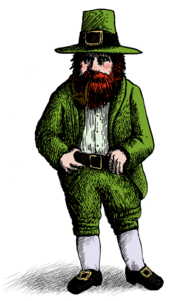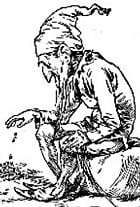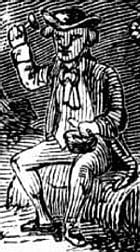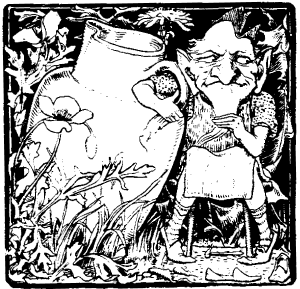Difference between revisions of "Leprechaun" - New World Encyclopedia
(Claimed) |
|||
| Line 2: | Line 2: | ||
[[Category:Anthropology]] | [[Category:Anthropology]] | ||
| − | + | {{Claimed}} | |
| − | |||
| − | |||
| − | |||
[[Image:Leprechaun ill artlibre jnl.png|thumb|170px|A modern [[stereotype|stereotypical]] depiction of a Leprechaun of the type [[popular culture|popularised]] in the [[20th Century]].]] | [[Image:Leprechaun ill artlibre jnl.png|thumb|170px|A modern [[stereotype|stereotypical]] depiction of a Leprechaun of the type [[popular culture|popularised]] in the [[20th Century]].]] | ||
In [[Irish mythology]], a '''leprechaun''' ([[Irish language|Modern Irish]]: ''leipreachán'') is a type of male [[faerie]] said to inhabit the island of [[Ireland]]. They are a class of "[[faerie]] folk" associated in Irish mythology and folklore, as with all faeries, with the [[Tuatha Dé Danann]] and other quasi-historical races said to have inhabited Ireland before the arrival of the [[Celts]]. | In [[Irish mythology]], a '''leprechaun''' ([[Irish language|Modern Irish]]: ''leipreachán'') is a type of male [[faerie]] said to inhabit the island of [[Ireland]]. They are a class of "[[faerie]] folk" associated in Irish mythology and folklore, as with all faeries, with the [[Tuatha Dé Danann]] and other quasi-historical races said to have inhabited Ireland before the arrival of the [[Celts]]. | ||
Revision as of 22:08, 30 December 2006

In Irish mythology, a leprechaun (Modern Irish: leipreachán) is a type of male faerie said to inhabit the island of Ireland. They are a class of "faerie folk" associated in Irish mythology and folklore, as with all faeries, with the Tuatha Dé Danann and other quasi-historical races said to have inhabited Ireland before the arrival of the Celts.
Leprechauns and other creatures of Irish mythology are often associated with "faerie forts" or "faerie rings" — often the sites of ancient (Celtic or pre-Celtic) earthworks or drumlins.
They usually take the form of old men who enjoy partaking in mischief. Their trade is that of a cobbler or shoemaker. They are said to be very rich, having many treasure crocks buried during war-time. [1] According to legend, if anyone keeps an eye fixed upon one, he cannot escape, but the moment the eye is withdrawn he vanishes.
Etymology
There are a number of possible etymologies of the name "leprechaun". One of the most widely accepted theories is that the name comes from the Irish Gaelic word leipreachán, defined by Dinneen as "a pigmy, a sprite, a leprechaun; for luchorpán"; the latter word Dinneen defines as "a pigmy, a leprechaun; 'a kind of aqueous sprite'";[2] this word has also been identified as meaning "half-bodied", or "small-bodied". This is the etymology given in the Collins English Dictionary [3].
The word which is widely believed to be the root and one of the ones quoted by the Oxford English Dictionary is luchorpán. An alternative derivation for the name and another one quoted by the Oxford English Dictionary, is leath bhrógan, meaning shoe-maker — the leprechaun is known as the fairy shoemaker of Ireland and is often portrayed working on a single shoe.[4]

Another derivation has the word "leprechaun" deriving from luch-chromain, meaning "little stooping Lugh", Lugh being the name of a leader of the Tuatha Dé Danann.[5]
The word leprechaun was first recorded used in the English language in 1604 in Middleton and Dekker's The Honest Whore as lubrican. The original meaning was of some kind of spirit and not specifically associated with the Irish mythological character:[6]
- "As for your Irish Lubrican, that spirit
- Whom by preposterous charms thy lust has raised." [7]
Some alternative spellings of the word leprechaun that have been used throughout the ages are; leprechawn, lepracaun and lubberkin. The word leprehaun has also been used.
Mythology
Leprechauns rarely appear in what would be classed as a folk tale; in almost all cases the interest of these stories centres round a human hero. Stories about leprechauns are generally very brief and generally have local names and scenery attached to them. The tales are usually told conversationally as any other occurrence might be told, whereas there is a certain solemnity about the repetition of a folk-tale proper.
In most tales and stories leprechauns are depicted as generally harmless creatures who enjoy solitude and live in remote locations, although opinion is divided as to if they ever enjoy the company of other spirits. Although rarely seen in social situations, leprechauns are supposedly very well spoken and, if ever spoken to, could make good conversation.

Among the most popular of beliefs about leprechauns is that they are extremely wealthy and like to hide their gold in secret locations, which can only be revealed if a person were to actually capture and interrogate a leprechaun for its money.
By nature, leprechauns are said to be ill-natured and mischievous, with a mind for cunning. Many tales present the leprechaun as outwitting a human, as in the following examples.
Examples of tales involving leprechauns
A farmer or young lad captures a leprechaun and forces him to reveal the location of his buried treasure. The leprechaun assures him that the treasure is buried in an open field beneath a particular ragwort plant. The farmer ties a red ribbon to the plant, first extracting a promise from the leprechaun not to remove the ribbon. Releasing the leprechaun, he leaves to get a shovel. Upon his return he finds that every weed in the field has been tied with an identical red ribbon, thus making it impossible to find the treasure.[8] [9]
In another story, a young girl finds a leprechaun and bids him show her the location of his buried money. She takes him up in her hand and sets out to find the treasure, but all of a sudden she hears a loud buzzing behind her. The leprechaun shouts at her that she is being chased by a swarm of bees, but when she looks around there are no bees and the leprechaun has vanished. [10]
In other stories they are told of riding shepherds' dogs through the night, leaving the dogs exhausted and dirty in the morning.
Appearance
The leprechaun originally had a different appearance depending on where in Ireland he was found.[11] Prior to the 20th century, it was generally agreed that the leprechaun wore red and not green. Samuel Lover, writing in the 1831 describes the leprechaun as,
- ... quite a beau in his dress, notwithstanding, for he wears a red square-cut coat, richly laced with gold, waistcoat and inexpressible of the same, cocked hat, shoes and buckles. [12]
Yeats, in his 1888 book entitled Fairy and Folk Tales of the Irish Peasantry describes the leprechaun as follows:
- He is something of a dandy, and dresses in a red coat with seven rows of buttons, seven buttons on each row, and wears a cocked-hat, upon whose pointed end he is wont in the north-eastern counties, according to McAnally, to spin like a top when the fit seizes him.[13]
In a poem entitled The Lepracaun; or, Fairy Shoemaker, the 18th century Irish poet William Allingham describes the appearance of the leprechaun as:
- ...A wrinkled, wizen'd, and bearded Elf,
- Spectacles stuck on his pointed nose,
- Silver buckles to his hose,
- Leather apron - shoe in his lap... [14]
Some commentators accuse Allingham of leaving the legacy of the modern image of the leprechaun described below. [15]
The modern image of the leprechaun is almost invariant: he is depicted wearing an emerald green frock coat, and bestowed with the knowledge of the location of buried treasure, often in a crock of gold.
Related creatures
The leprechaun is related to the clurichaun and the far darrig in that he is a solitary creature. Some writers even go as far as to substitute these second two less well-known spirits for the leprechaun in stories or tales to reach a wider audience. The cluricaun is considered by some to be merely a leprechaun on a spree [16].
In politics
In the politics of the Republic of Ireland, leprechauns have been used to refer to the twee aspects of the tourist industry in Ireland [17] [18]. This can be seen from this example of John A. Costello addressing the Oireachtas in 1963:
- For many years, we were afflicted with the miserable trivialities of our tourist advertising. Sometimes it descended to the lowest depths, to the caubeen and the shillelagh, not to speak of the leprechaun. [19]
Leprechauns have also been used in jokes regarding fiscal irresponsibility, the idea being that the politician or political party being attacked has found a pot of gold, or is going to ask a leprechaun for the location of such a pot, accommodating their spending.
The term leprechaun language, used by some Unionists in Northern Ireland, is a pejorative for the Irish language. [20]
Popular culture
Movies, television cartoons and advertising have popularized a specific image of leprechauns which bears scant resemblance to anything found in the cycles of Irish mythology. Many Irish people find the popularised image of a leprechaun to be little more than a series of offensive Irish stereotypes and a trivialisation of Ireland's rich and ancient culture.
The stereotypical image of a leprechaun bedecked in green is particularly strong in the United States, where it is widely used for a variety of purposes, both commercial and non-commercial.
See also
- Clurichaun ("cousin" of the Leprechaun)
- Far darrig
- Kallikantzaros
- Menehune
- Sprite (creature)
- Cultural appropriation
Notes
- ^ From Fairy and Folk Tales of the Irish Peasantry.
- ^ Dinneen, Patrick, Foclóir Gaedhilge agus Béarla, Dublin: Irish Texts Society, 1927
- ^ Hanks, Patrick, ed. Collins Dictionary of the English Language, London: William Collins Sons & Co. Ltd, 1979
- ^ Oxford English Dictionary (full ed.) (1989).
- ^ Ireland Now - The Leprechauns.
- ^ Oxford English Dictionary (full ed.) (1989).
- ^ The Fairy Mythology by Thomas Keightley - Ireland
- ^ The Field of Boliauns - A typical tale involving a leprechaun printed in the 1800s.
- ^ Clever Tom and the Leprechaun
- ^ The Leprechaun in the Garden
- ^ Little Guy Style
- ^ From Legends and Stories of Ireland
- ^ From Fairy and Folk Tales of the Irish Peasantry.
- ^ William Allingham - The Leprechaun
- ^ Criticism of William Allingham's The Fairies
- ^ From Fairy and Folk Tales of the Irish Peasantry.
- ^ Dáil Éireann - Volume 495 - 20 October, 1998 - Tourist Traffic Bill, 1998: Second Stage.
- ^ Dáil Éireann - Volume 206 - 11 December, 1963 Committee on Finance. - Vote 13—An Chomhairle Ealaoín.
- ^ Dáil Éireann - Volume 206 - 11 December, 1963 Committee on Finance. - Vote 13—An Chomhairle Ealaoín.
- ^ Republican Sinn Féin - AN GHAEILGE Why it is so important
Further reading
- Croker, T. C. (1862) Fairy Legends and Traditions of the South of Ireland
- Yeats, W. B. (1888) Fairy and Folk Tales of the Irish Peasantry — available online here
- McAnally, D. R. (1900) The Leprechawn
- Lover, S. (1831) Legends and Stories of Ireland — available online here
- Hyde, D. (1910) Beside The Fire — available online here
- Keightley, T. (1870) The Fairy Mythology: Illustrative of the Romance and Superstition of Various Countries — available online here
- Wilde, F. S. (1887) Ancient Legends, Mystic Charms, and Superstitions of Ireland — available online here
External links
- The Leprechaun Companion (an illustrated guide)
Credits
New World Encyclopedia writers and editors rewrote and completed the Wikipedia article in accordance with New World Encyclopedia standards. This article abides by terms of the Creative Commons CC-by-sa 3.0 License (CC-by-sa), which may be used and disseminated with proper attribution. Credit is due under the terms of this license that can reference both the New World Encyclopedia contributors and the selfless volunteer contributors of the Wikimedia Foundation. To cite this article click here for a list of acceptable citing formats.The history of earlier contributions by wikipedians is accessible to researchers here:
The history of this article since it was imported to New World Encyclopedia:
Note: Some restrictions may apply to use of individual images which are separately licensed.


